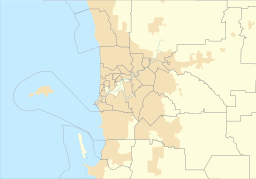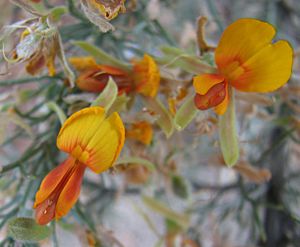Thomsons Lake facts for kids
Quick facts for kids Thomsons Lake |
|
|---|---|
| Location | Perth, Western Australia |
| Coordinates | 32°09′00″S 115°49′45″E / 32.15000°S 115.82917°E |
| Type | Brackish seasonal groundwater |
| Primary outflows | groundwater; evaporation |
| Basin countries | Australia |
| Designation | Thomsons Lake Nature Reserve; Forrestdale and Thomsons Lakes Ramsar Site |
| Max. length | 1.6 km (0.99 mi) |
| Max. width | 1.3 km (0.81 mi) |
| Surface area | 5.38 km2 (2.08 sq mi) |
| Surface elevation | 12 m (39 ft) |
Thomsons Lake Nature Reserve is a special place in Western Australia. It's a nature reserve that protects a beautiful lake called Thomsons Lake. This lake is located in the City of Cockburn, about 25 kilometers south of Perth, the capital city. It's also about 7 kilometers southwest of Jandakot Airport. Thomsons Lake is a mostly natural wetland, which means it's an area of land covered by water, like a swamp or marsh. It has native plants around it and is surrounded by homes and farms. Many shorebirds and other waterbirds love to visit this lake regularly.
Contents
Protecting Thomsons Lake
Thomsons Lake is very important, so it has special protection. It is listed on the Register of the National Estate, which means it's a place of national importance.
International Importance: Ramsar Site
Along with Forrestdale Lake, which is 10 kilometers to the east, Thomsons Lake forms the Forrestdale and Thomsons Lakes Ramsar Site. This site was named under the Ramsar Convention on June 7, 1990. The Ramsar Convention is an international agreement that recognizes wetlands that are important for the world. This means Thomsons Lake is a wetland of international importance!
Local Management and Park Status
The lake and the land around it are registered as Nature Reserve 15556. This reserve is managed by the Department of Conservation and Land Management. It is also part of the Beeliar Regional Park, which helps protect natural areas in the region.
About Thomsons Lake Nature Reserve
Thomsons Lake Nature Reserve, including the lake and nearby woodlands, covers an area of 538 hectares. The lake itself is shallow and has slightly salty water, which is called brackish. It's a seasonal lake, meaning it often dries out in the summer. However, sometimes it keeps some water all year.
A Home for Waterbirds
When the lake is full, it has a large area of open water. It also has many sedges (grass-like plants) growing around its edges. This makes it a major breeding spot for waterbirds. It's also a place where birds stop during their long migrations. Plus, it's a safe place for birds to go when there's a drought (a long period without rain).
Activities at the Reserve
The reserve is fenced to keep out animals that might harm the wildlife. People mostly use the reserve for birdwatching, nature walks, and just enjoying the outdoors. There are tracks inside the reserve for walking. Horse riding is allowed only on a path around the outside of the fence.
How the Lake Formed
The lake sits in a dip between two old sand dune systems. These dunes were formed by sand from ancient beaches and strong winds. Studies of old plants (palaeobotanical studies) show that the lake's mud is 30,000 to 40,000 years old! This makes its sediments the oldest found in Western Australia. The lake also sits on the Jandakot Mound, which is an area where the underground water level is higher.
Plants and Animals of Thomsons Lake
Thomsons Lake is home to many different kinds of plants and animals.
Lake Plants and Trees
You'll find lots of water milfoil growing in the lake. Around the edges, there's a lot of introduced bulrush and the sedge Baumea articulata. When the water level drops, another plant called Bolboschoenus caldwellii grows on the exposed muddy areas. Behind these, you'll see Baumea juncea and Baumea articulata with native broom and orange wattle shrubs.
Further from the water, there are trees like flooded gum and stout paperbark, and the shrub grey stinkwood. On higher ground, you'll find open forests with jarrah, firewood banksia, and candlestick banksia trees. In total, about 476 different types of vascular plants (plants with tubes for water and nutrients) have been found here. This includes 133 types of introduced weeds.
Amazing Birds and Wildlife
Thomsons Lake is one of the last safe places for the endangered Australasian bittern on the Swan Coastal Plain. It's also the only wetland in the Perth area where the marsh harrier still breeds. It's one of the few places where Baillon's crake is known to breed.
The lake often has more than 10,000 waterbirds, and sometimes even over 20,000! It regularly supports more than 1% of Australia's population of four types of shorebirds:
- Red-capped plover (up to 1,000 counted)
- Black-winged stilt (3,000)
- Red-necked avocet (3,000)
- Curlew sandpiper (2,500)
The most common birds you might see include:
- Australian shelduck (up to 1,600 counted)
- Pacific black duck (4,500)
- Grey teal (6,000)
- Australasian shoveler (2,000)
- Eurasian coot (7,000)
Besides birds, the reserve is home to western grey kangaroos and the long-necked tortoise. Six different frog species and up to 80 types of aquatic invertebrates (animals without backbones, like insects and worms) have also been recorded here.





